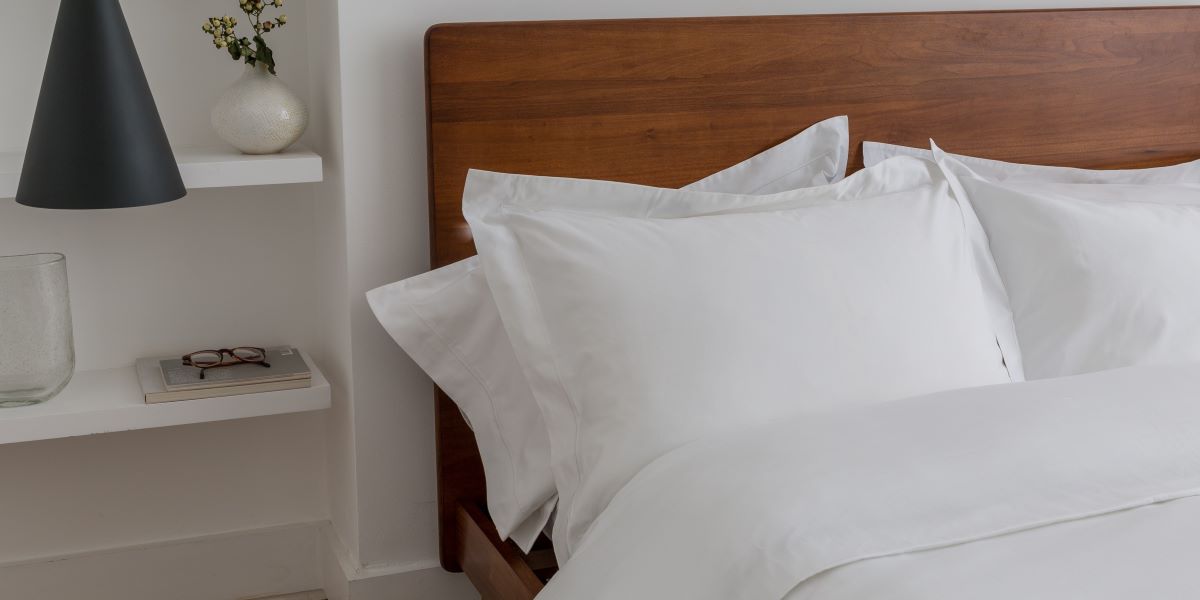There is nothing better than sinking into clean sheets at night. The fresh aromas and crisp feel that greets you at night time is unbeatable - it just might be the ultimate “ahh” feeling. However, knowing how to wash and care for your bedding properly is key to enjoying your bed at its cosiest. This isn’t always easy though, and there are often things standing in the way of ideal sleeping conditions, from finding the right bed sheets to stressful small print care instructions and panic Google searches.
So, how do you get the very best results when washing your bedding? We’ve put together some Sleep Expertise in this guide to caring for bedding correctly, so you can feel confident the next time you wash your bed sheets, pillows and duvet. Now let’s dive right in!
What temperature should I wash my bed sheets on?
There's a lot of debate around the best temperature to wash your bedding, but as a general rule of thumb, we'd always recommend adhering to the care labels and following the instructions.
Most fabrics can be washed at a warm temperature of 40° as this helps to remove dirt, natural body oils and takes care of germs.
Silk bed sheets should be washed at a lower temperature of 30° with a mild, non-biological detergent, or a silk specialist washing detergent.

How often should I wash my bed sheets?
How often you care for your bed linen sheets is usually a personal preference. They cover the body of your bed and they tend to show all the obvious signs of dirt marks/stains. To make your bedroom a stress free-zone, we suggest that you change your sheets at least once a week.
When buying any new sheets, we always recommend that you first consider the Thread Count (TC). We also advise that you look into what type of materials make the difference for you (e.g. polycotton, French linen etc). The longer fibres create a softer, more durable fabric that feels fresh and light to the touch of your skin.
We understand that it’s not always convenient to wash your bedding this frequently so having spare bedding is extremely helpful. Simply swap the sets once a week and add them to the wash load when it’s most suitable for you.
White sheets should be washed once a week to keep them looking crisp and to prevent a build-up of stains.

How should I wash my bedding?
For the very best results, always wash your new bedding before first use.
Most modern washing machines have a dedicated cycle for washing bed sheets - alternatively, it's best to use a normal, gentle cycle. Using a heavy-duty cycle will cause the sheets to get tangled and can damage the fibres.
Silk bedding should be washed on a gentle cycle to protect its natural fibres. Top tip - place silk items in a laundry bag to prevent the fibres from catching and snagging.
If you are washing a patterned or coloured duvet cover or pillowcase, remember to turn them inside out before you put them through the wash to protect the colours.
How to wash linen bedding
Linen is a beautiful fabric that only gets better when it's washed and cared for properly. When washing French Linen please ensure that you do not use any products containing bleach, this will affect the colour and durability of the fabric. Be sure to use the correct detergent and avoid optical brighteners. Choose a gel or detergent that are specific for coloured fabrics.
You can tumble try your linen bedsheets but they are best left to air dry if you have the space. Linen has a wonderful rumpled texture that lends itself to being left un-ironed. Or if you prefer a more pristine look, linen can be ironed on a low temperature and whilst it's still damp.

Should I tumble dry bed sheets?
Most bed sheets can be tumble dried, be sure to check the care labels individually first. We suggest a combination of machine and air drying (where possible). Air or line drying your bedding is better for the environment.
Keep the temperature on a low heat and dry items in small loads to allow the sheets to dry evenly.
Remove the sheets from the dryer whilst still slightly damp and hang them out to air dry, this will help to naturally iron out some of the creases.
Hang out your silk sheets to dry naturally in the air - never tumble dry silk sheets as this will damage the precious fabric.
Can I iron my bed sheets?
Iron your bed sheets if you love the soft, luxury look, we recommend removing them from the tumble dryer whilst still slightly damp and ironing on a low heat. Silk sheets can be ironed too but on the coolest, silk setting and not until they are completely dry.
Not a fan of ironing? Our French Linen range is a popular option as it's need little to no ironing due to it's more relaxed, live-in feel.
For light coloured linens, iron on both sides, for dark or coloured linens, iron the reverse side only. Ironing your sheets can help to remove the remaining germs and dust mites.

5 handy tips for keeping bedding fresh and clean
1. Use a mattress protector.
Your mattress is too big to go in the wash, whereas protectors can be washed along with your normal bedding cycle. They are handy to keep away nasties from your bedding for those allergy sufferers too.
2. Wash your bedding on its own
Wash your bedding on its own, that way it can move around freely in the washing machine, giving your sheets a more even wash.
3. Vacuum your mattress
Vacuum your mattress once every few months. Use the lowest suction setting with a upholstery attachment. Always check the care guide as some mattresses cannot be vacuumed as it moves the filling inside.
4. Take out the towels
Avoid drying your bed linen with your towels. This can take longer to dry and you may end up shrinking your pillow cases.
5. Wash on a low heat
Wash pillows and duvets on a very low heat, if your washing machine load is large enough - if not, take them to the dry cleaners and leave it to the experts! For best results, leave them to air dry. Always read the care labels before washing.
How to Wash Pillows
Whilst you're learning about how to keep your bed linen in tip top condition, read more about how to keep your other bedding goods feel like new.
1. Start with using a protector
To begin with, we always recommend that you use a pillow protector in case of any accidental spills. It is important that you wash your pillow protectors frequently to let the fibres breathe. If you're an allergy sufferer or someone that generally struggles to get to sleep in the heat, then we would also recommend purchasing a second set to allow you to rotate in a weekly wash.
2. When and how to clean pillows
As most of our pillows have a generous fill, we usually recommend that you use a professional laundering service at your local dry cleaner. Nevertheless, you can still wash your pillow from home at a low 30/40 temperature. Just try to avoid overloading your washing machine, and make sure it is 100% bone dry to avoid any ruining of the fill.
TOP TIP - Weigh your pillow pre & post-wash. If it weighs the same, then it should be bone dry and ready to use again.
Check our Buying & Care guides if you have any specific questions on how you should look after your pillows.
How to Wash a Duvet
How often should you wash your duvet?
Whether it is a feather and down, wool, synthetic or silk-filled duvet, we suggest that you wash your duvets every 6-12 months (in line with each season). Depending on what tog size duvet you have, we recommend professional laundering for the higher tog, larger duvets, and to be cautious you don’t overfill your washing machine when you care for your smaller, lighter tog duvet.
How to dry a duvet
After washing, the drying stage will require you to be patient in order to avoid any clumping and to make sure it is 100% dry throughout. But if you do want to speed up the process, then tumble dry with ‘tumble dry balls’, to keep your duvet nice and fluffy. For any additional information, we always recommend that you check our simple care labels.
TOP TIP - Get into good habits and switch your duvet each season, as you will sleep better depending on the type of tog you have. View our Duvet Buying Guide to find out more.
Bonus bedding care advice
When you invest in soft, comfortable, bedding, you want it to always be clean, inviting and in the best possible condition. So our final bedding care tip is all about showing your duvet and pillows a little TLC every morning. Give them a gentle shake, plump, and a spruce to help maintain the fill and structure. You’ll thank us later.
With all the top sleep tools & services right at your door, our mission is to make your life a blissful breeze when you sleep with us. With our extensive range of buying, care guides, detailed videos, returns & guarantees policies, price promises and reliable trusted delivery & tracking processes, you would be a fool to miss out on our great range of loved products. Over 10,000 people would say we offer 5-star bedding!
So there you have it, our expert guide on washing your bedding and keeping that super fresh feeling. You can read more about keeping those white sheets as white as ever, here.
Got any more top-tips, we'd love to hear them! Please feel free to leave a comment below.
Visit our website to discover our full range of products.





